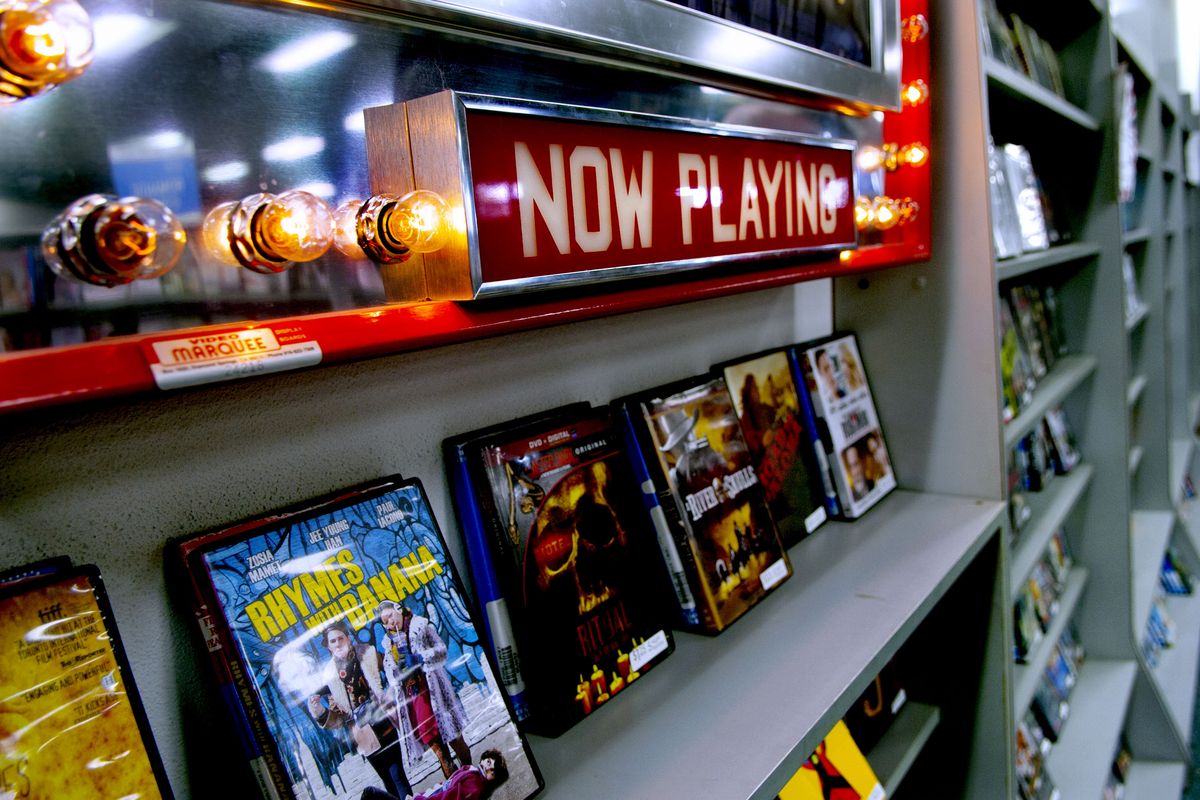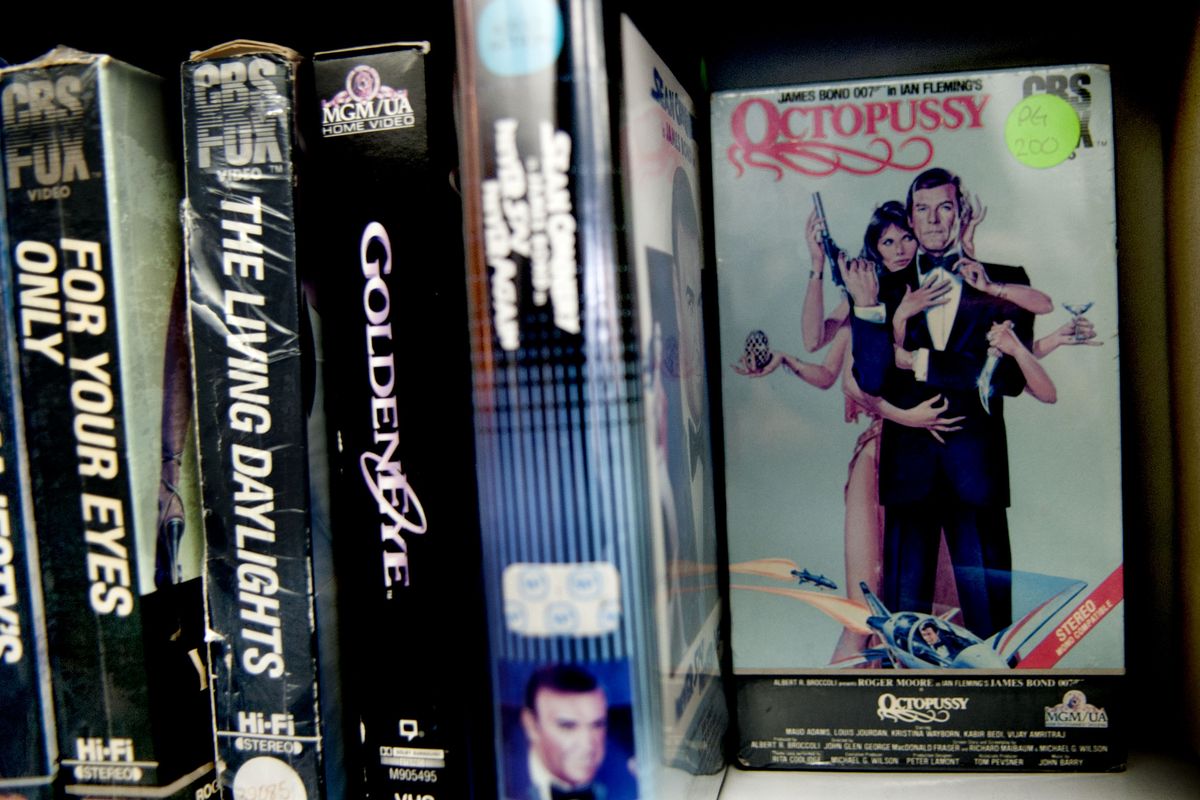Video hosting
Once-cluttered video store landscape is down, but thanks to a dedicated group of renters, not out
Store employee Kolton Koppa stands before shelves of movies at Video Theater in Coeur d’Alene. Video Theater, which also operates a store in Post Falls, is the only independently owned video rental shop still in operation in the area. (Kathy Plonka)Buy a print of this photo
When Steve and Jannice Turk opened the first Video Theater location in Post Falls in 1984, the concept of watching movies at home was still a relatively new one. Owning your own tapes was a rather expensive hobby – VCRs typically retailed for several hundreds of dollars, and a stack of VHS tapes wasn’t much cheaper – so the rental store represented an acceptable compromise.
The Turks had no real competition when they launched the store, and their initial in-store stock consisted of about 300 tapes and 20 or so loaner VCRs. Business was steady enough – and the industry developed quickly enough – that they were able to open a second store in Coeur d’Alene a couple years later.
A lot has happened in the decades that followed.
VHS clobbered its main tape competitor Betamax, reigning as the favored home video format until the shiny allure of DVD brought about its extinction.
Blockbuster and Hollywood Video, national chains that had once posed a serious threat to mom-and-pop rental stores, both folded: Hollywood declared bankruptcy in 2010; Blockbuster closed all of its company-owned locations in 2013.
The convenience of on-demand services like Netflix and the proliferation of Redbox rental kiosks have made video stores less of a necessity, and anything not available through those means can generally be rented or purchased digitally from Amazon and iTunes.
Today’s home video landscape is totally unrecognizable from what it once was, but one thing hasn’t changed: Both Video Theaters are still open, and they’re once again the only standalone video stores in the Spokane-Coeur d’Alene area.
That wasn’t the case in the late ’80s, when the novelty of home video resulted in what could easily be described as a video store boom.
“It was like coffee stands are now – there were video stores everywhere,” Jannice Turk said.
By 1990, there were more than 25,000 video stores in the country, and it was estimated that 70 percent of American households owned a VCR. Jack Valenti, then head of the MPAA, famously announced that the popularity of home video signaled the impending death of the movie theater, inelegantly comparing the advent of the VCR to the murderous rampage of the Boston Strangler. Blockbuster soon established itself as the granddaddy of rental chains, and it operated about 9,000 locations during its peak.
Most of those stores are gone now: According to Blockbuster’s website, only 51 franchised locations still exist, and none of them are in Washington or Idaho.
“They just slowly filtered out,” Turk said. “But we’ve been able to keep our niche of people who still want to go in, look around and have something in hand.”
So don’t write an obituary for the video store quite yet.
Seattle’s Scarecrow Video, the largest independently owned video rental store in the country, is still in operation as a nonprofit, and its exhaustive collection of tapes and discs appeals primarily to film obsessives and completists.
An Illinois-based chain called Family Video is still booming: They have well over 750 locations, many outfitted with adjacent pizza joints, making them by far the largest brick-and-mortar rental company in the U.S.
Hastings Entertainment, which also stocks CDs, books and video games, still offers rentals in 126 of its superstores, including those in Spokane and Coeur d’Alene.
In 2013, the same year Blockbuster shut its doors, Bloomberg Business reported that video rentals accounted for 72 percent of “the $18 billion home video market.”
Video Theater has kept its rental prices manageable: New releases run $3.99 and you can keep them for two nights; older titles are $1.25 for a five-night rental, and the price is reduced to $1 apiece if you rent five or more. The store still keeps vintage video games and VHS tapes in stock, too, and they’re still being rented: Kolton Koppa, who has worked for Video Theater for seven years, estimates he rents out at least one VHS tape a day.
“We do get older people coming in who haven’t quite caught up with technology, so they’re still renting tapes,” he said. “And some movies you can’t find on anything but tape, so it’s kind of your only option.”
“You think about what your average customer is like, and there really isn’t one,” Turk said. “We have people who don’t want to progress with the technology of on demand, but we also have young people coming in with dates and finding movies together. And we have people who bring in their kids because, for $1.25, they can keep a movie for five nights that they can watch over and over.”
As I was wandering through Video Theater a few days ago, I tried thinking back to the last time I had stepped foot inside an honest-to-god video store, and I drew a blank. I felt a certain nostalgia: I remember spending what seemed like hours ogling one VHS box after another, carefully considering my weekly rental choice, only to plunk down a wrinkled dollar for that same copy of “Ferris Bueller’s Day Off” for the thousandth time.
Renting a video is a tactile experience: Just as downloading an album from the iTunes database isn’t the same as thumbing through bins of vinyl in a record store, services like Redbox and Netflix simply can’t capture what it’s like to weave through the overstocked shelves of an impeccably curated video store. There’s also an inherent degree of unpredictability to the rental store model: You might go in knowing what you’re looking for, but you could come out with something unexpected.
“There are still people who want a social experience out of it,” Turk said. “They come in, there are other people in there, we’re friendly to them. A lot of people don’t know what they want when they come in and they want suggestions.”
“We are competing with Redbox and Netflix,” Koppa said, “but to actually physically come into the store expands your mood for what you want to rent. I think that helps.”
So how has Video Theater been able to hang in there for so long, after all its competitors have shut down one by one? Turk says a lot of it has to do with the simple act of valuing every customer that comes into her stores.
“We have weekly customers, customers we’ve had since we’ve opened, their kids and their kid’s kids,” she said. “We’ve always tried to do fair business. We’ve never fallen into the gimmicks of advertising something to get people in the door and then that’s not what it is. We’re simple and straightforward and fair with people.”


